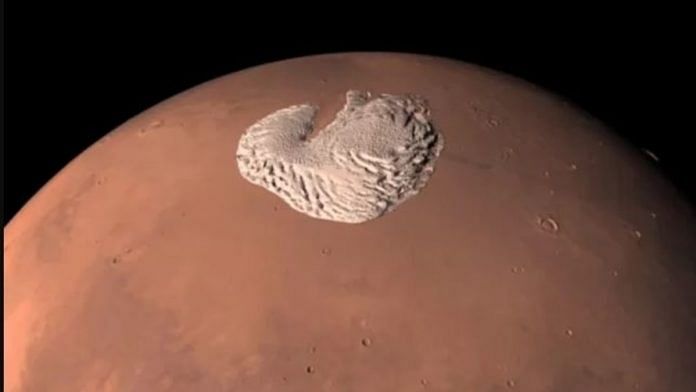Bengaluru: In 2018, the radar onboard the European Space Agency’s Mars Express orbiter was announced to have found evidence of lakes of salt water underneath the ice at the south pole of the Red Planet.
Now, three different teams of scientists have reanalysed the data and conducted experiments to demonstrate that the radar signals were likely from frozen clay, not liquid water.
The findings have been published in a series of three papers over a month. The latest paper from York University was published in the journal Geophysical Research Letters Thursday.
Also read: Canadian rocks dating back 890 mn yrs are oldest animal fossils? Not all scientists agree
Findings in the papers
The York paper proposed that the bright radar reflections, which were interpreted as brine or salt water, are actually hydrated and cold clay-rich deposits. The researchers further showed experimental measurements and modelling, which demonstrated that the clay mineral called smectite can produce similar radar responses.
Last month, scientists at NASA-JPL published a paper in the same journal after analysing more data from the radar instrument on the orbiter from a larger area around the south pole, and over a larger time period. They said that there were dozens of similar radar responses observed around the South Pole indicating that the readings are either not unique or that liquid water was much more common than we think possible.
In the paper, the scientists outlined that multiple readings were taken in places where the temperature was -63 deg C, where it would be too cold for water to remain liquid, even if it contained salty minerals that can lower its freezing point.
A team from Arizona State University published a theoretical paper last month putting forth alternative materials that could produce similar radar response signals resulting from a contrast in electric conductivity, including salty ice and metallic minerals.
Radar signals can penetrate rock and ice, and they also reflect off material like water and metals.
The theories, findings, and proposals came about after the close-knit Mars polar scientist community met at a conference in Argentina in January 2020, after the exciting subsurface lakes paper was published.
The community started to investigate the conditions required to sustain such underground liquid salt water lakes for millions of years.
The Mars atmosphere
Mars is extremely cold and try today, with no liquid water on the surface, no measurable atmosphere, and no viable magnetosphere, despite the fact that over 3 billion years ago it was likely similar to Earth with an atmosphere, a water cycle, and much warmer conditions.
However, previous research has suggested that the conditions on the planet today are not conducive for subsurface lakes, and the only possible explanation for these lakes to persist would be recent underground volcanism.
The authors of the York paper also mentioned that the amount of dissolved salt in water and the temperature required to maintain liquid water are “difficult to reconcile with what we know about Mars”, prompting for alternative explanations for the readings.
In their lab, the team froze clay samples and bounced radar off them. The readings matched signals from Mars Express.
The findings follow the ongoing back-and-forth with the dark streaks known as recurring slope lineae on the surface of Mars, thought by some scientists to be seasonal downslope flow of salt water.
However, many others still contend that the lines are caused by dust settling on slopes triggering sand flows, which then expose the darker material under the surface, making them appear wet in images taken by orbiters.
The presence of liquid water is a vital clue to astrobiologists in search for life and habitable conditions outside of Earth.
Also read: This star’s death billions of years ago is challenging what we know about supernovae



